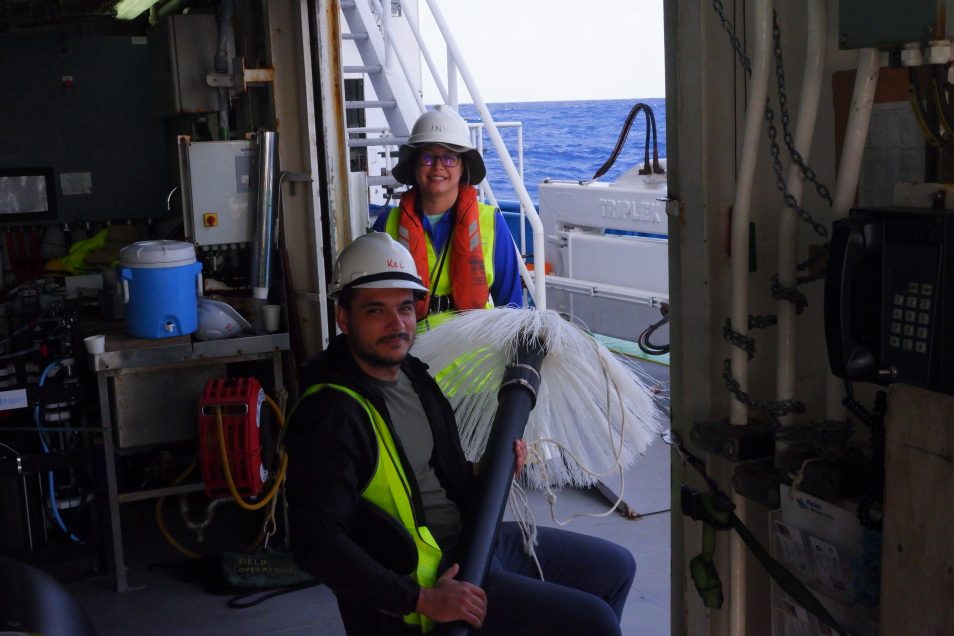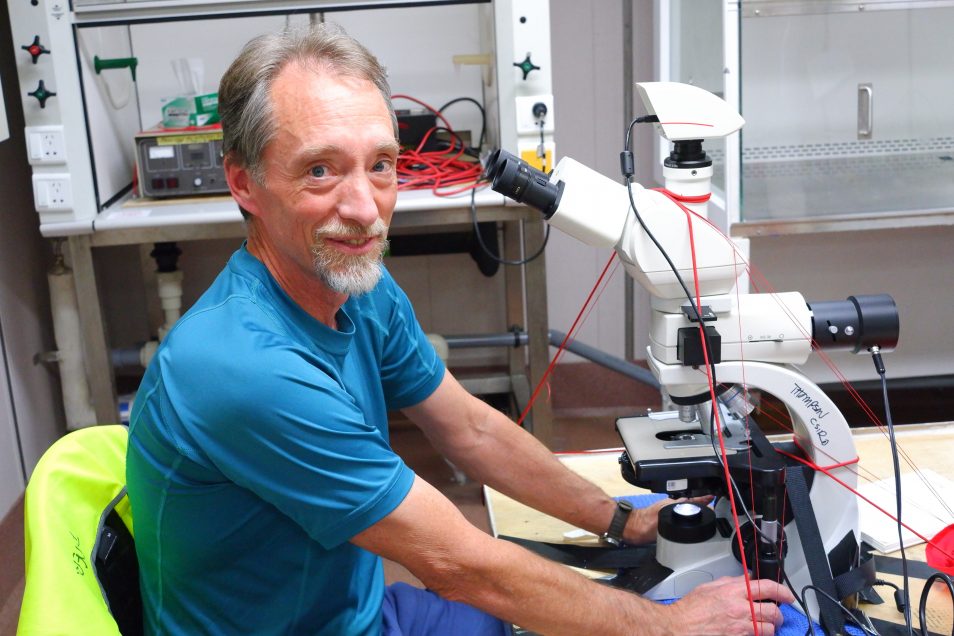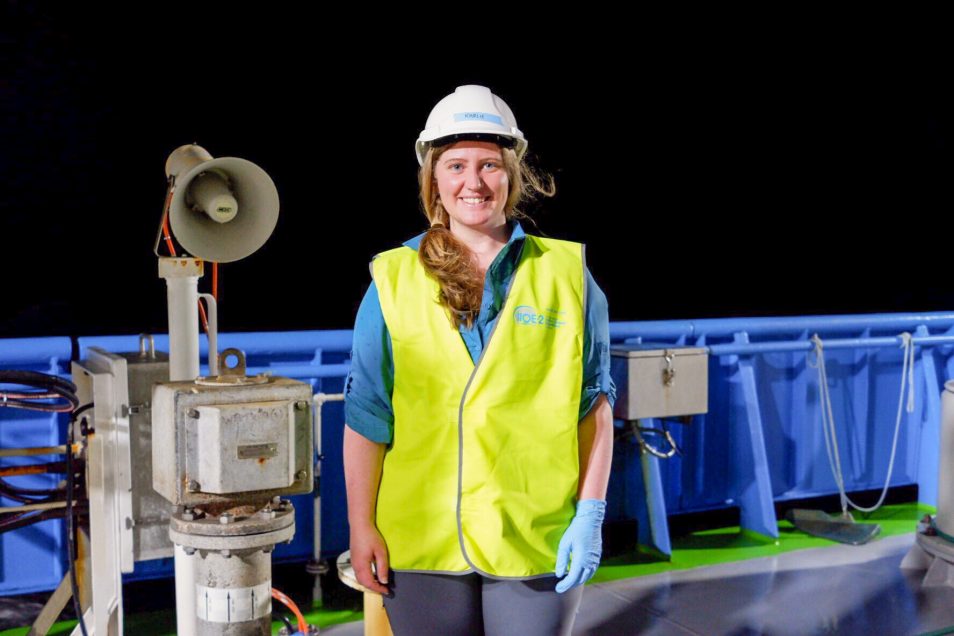
From the 110⁰ E meridional line in the Indian Ocean from 40⁰S where the Indian Ocean joins the Southern Ocean to the tropical waters at 10⁰S near Christmas Island, we hope our scientists don’t get seasick!
Over 2.5 billion people from 32 countries live around the border of the Indian Ocean. Fishing industries located here produced a significant percentage of the world’s annual catch. And they continue to increase yields while employing tens of millions of people. However, the Indian Ocean is the fastest warming ocean in the world and is at risk of being impacted by climate change. One factor of climate change, ocean acidification, could threaten food security and economic prosperity for a third of the world’s population.
With Australia having the world’s longest coastline in the Indian Ocean, we spoke with four of our researchers currently aboard our RV Investigator for the UN-led Second International Indian Ocean Expedition (IIOE-2). They are travelling from where the Indian Ocean joins the Southern Ocean to the tropical waters near Christmas Island.
Hunting plankton in converging waters – Claire Davies (Experimental Scientist)
The Leeuwin Current on Australia’s west coast is the only ocean current of its kind (subtropical eastern boundary current). It plays a major role in the distribution of marine life.
The Leeuwin Current transports warm, low nutrient waters and ocean creatures from the tropics southward along the Australian coast. A deep ocean current delivers high nutrient, cold water into the Indian Ocean from the Southern Ocean.
The complex relationships and mixing between these waters creates zones of unique phyto- and zoo- plankton communities along the west Australian coast. Claire Davies is investigating using a device called the continuous plankton recorder (CPR).

Ocean discoveries: new plankton has already been sighted on the voyage.
“The CPR collects plankton samples 10 metres below the surface for us to study,” explained Claire. “We can then map their distributions and abundances across our oceans.”
The CPR kit is an oldie but a goodie, remaining unchanged since 1927. However, for the first time, it will provide a gap-free record of the plankton in the Indian Ocean. Helping us to understand the effect of the Leeuwin Current and eddy systems on the mix of plankton species that live from tropical to temperate regions. Already, the results have Claire excited.
“I’ve already seen a lot of plankton new to me, and we may even find species new to science!”

Claire Davies is collecting plankton to better understand their composition in tropical and temperate regions.
Turbulence: the last great oceanographic frontier – Maxime Marin (PhD Student)
Max is using a unique instrument called a vertical microstructure (turbulence) profiler (VMP) to measure the ‘mixing of water’. Scientifically speaking the instrument measures the vertical velocity shear throughout the water column at a very high resolution.. It’s not an easy task. “You don’t realise how hard it is to get data. The ocean is wild,” said Max.
This is Max’s first voyage onboard the RV Investigator, and he is addressing a relatively new ocean challenge – understanding and modelling its turbulent mixing. Understanding turbulent mixing helps us to improve ocean models accuracy and prediction skill. Large scale first order dynamics are well resolved by most models, but resolving the second order flow remains a challenge and demands more observations.
“The 110 ⁰E voyage will help to determine the role of the Indian Ocean in regulating the climate in the region,” said Max. “We are comparing how the Indian Ocean flows and how physical conditions have changed over the past half a century since the transect was first studied. New technologies also enable us to measure processes on a much finer scale. This will generate more accurate climate and oceanographic models and satellite products to gain insights into the physical conditions of the Indian Ocean’s subsurface.”

Let there be light: Maxime Marin (front) is joining the voyage for the first time to study turbidity of the Indian Ocean
Healthy oceans, habitable planet – Dr Peter Thompson (Research Group Leader)
The world’s oceans provide up to 80 per cent of the oxygen we breathe – and phytoplankton produces 330 billion tonnes of oxygen each year! This oxygen is produced when microscopic plants, called phytoplankton, photosynthesize, just like a plant on land does.
Along with being a source of oxygen, phytoplankton sits at the bottom of the marine food web, providing a source of nutrition for fish and baleen whales. With the Indian Ocean warming the fastest in the world, it’s these tiny critters that will be affected first.
“I am conducting nutrient assessments along the 110 ⁰E meridional line to understand whether the nutrients essential for phytoplankton growth and photosynthesis (carbon, phosphorous, nitrogen and silicate) have become less available as the ocean warms up,” reveals Peter Thompson.
“Water sampling is extensive, as phytoplankton can grow to nearly 175 metres below the ocean surface, so it will be a few months until we can compare data collected over the last 60 years as to whether the nutrient concentrations are changing in the east Indian Ocean and, if so, by how much.”

Red alert: the Indian Ocean is warming so Dr Peter Thompson is researching how ocean changes will impact plankton.
Future oceans in a high CO2 world – Dr Karlie McDonald (Research Fellow)
Each year, 40 billion tonnes of carbon dioxide (CO2) is released into the earth’s atmosphere. Of which, at least 25% is assimilated into the world’s oceans. Ocean acidification occurs when the pH of seawater becomes acidic due to elevated CO2 uptake.
Karlie McDonald is improving our knowledge on CO2 assimilation and transport in the east Indian Ocean. She is measuring CO2 and alkalinity (a buffer of increasing pH) in seawater along the 110 ⁰E transect from the surface to 5000 metres deep. Karlie is also investigating how ocean acidification impairs marine life to protect social and economic values in the region.
“Ocean acidification impacts the construction of calcium carbonate shells and skeletal structures for sea butterflies and other calcifiers. Such as corals, crustaceans, and molluscs. This can have far-reaching impacts on the marine ecosystem, including fisheries and aquaculture,” states Karlie.

Coral crusader: Karlie McDonald is researching how carbon dioxide is transported through the Indian Ocean and how ocean acidification impacts the survival of marine life, like coral. Photo: Helen Phillips
This World Oceans Day, we want to say thank-you to our dedicated researchers making waves in marine science. This voyage on our RV Investigator is led by chief scientist Professor Lynnath Beckley from Murdoch University. CPR is funded by the Integrated Marine Observing System.


29th June 2019 at 10:02 am
The world’s oceans “provide up to 80 per cent of the oxygen we breathe” (Thompson) but “at least 25%” of carbon dioxide “is assimilated into the world’s oceans” (McDonald). How does that work?
28th June 2019 at 3:42 pm
The authors should have first done some ionic equilibria calculations – taught in First Year Chemistry – to see the extent that carbon dioxide may possibly affect pH and dissolved calcium levels. Saves ocean cruises!
[I’ve done the calculations at my site Planet Earth Climate Topics, pjcarson2015.wordpress.com]
The spread of pH across the oceans is about 0.3, (8.2 to 7.9) a range in [H+] of 100%. This pH range is equivalent to a huge atmospheric CO2 range of 0•032% to 0•0697%, whereas it is usually accepted that it is virtually homogeneous.
It is beyond belief for this open ocean pH range to be due to CO2. Therefore, it must be due to something else.
There’s also no problem with dissolution of calcium carbonate because seawater is greatly super-saturated with Ca(2+) ions.
28th June 2019 at 2:17 pm
You are correct that global average seawater is unlikely to go below a pH of 7 under most scenarios studied. However ‘ocean acidification’ means the addition of H+ ions to seawater. In the case of ocean uptake of anthropogenic CO2, through the formation of carbonic acid by the added CO2 and the dissociation of that carbonic acid. pH is the negative natural log of [H+], and the observed reduction of pH in the world’s oceans reflects the addition of ‘acid’ or H+.
So ‘acidification’ is a correct term to use for this process. Alternatively you could say the ocean is undergoing ‘de-alkalinisation’. That would be more difficult to pronounce.
7th June 2019 at 3:49 pm
Being picky, current additions of CO2 to the sea are not acidifying it. From what I have read, for a long time the pH of sea water was 8.2 and it is now 8.1, a long way from 6.9. But it is right in the area where calcium carbonate will come under pressure.
GW deniers leap on anything that we understand as evidence, but which isn’t exact. “Don’t these so-called scientists even understand acid and alkaline?” I can hear Alan Jones gleefully yelling.
Put the facts of where the solid calcium carbonate and liquid calcium bicarbonate balance is moving.